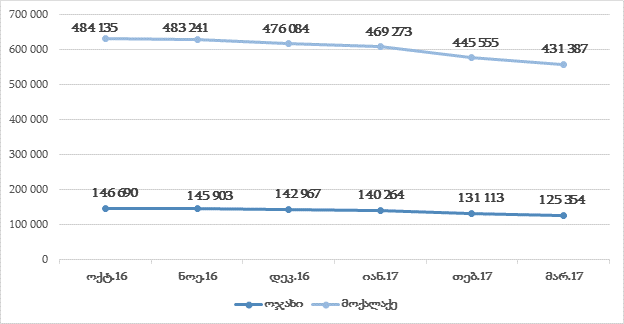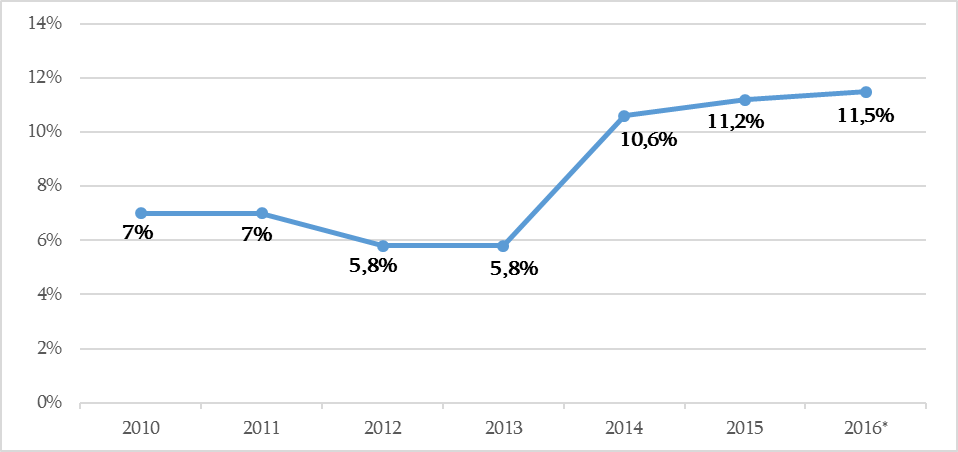On 30 March 2017, National Statistics Office of Georgia published the economic growth figures of February 2017. According to the data, in February 2017 real Gross Domestic Product (GDP) growth rate was 4.4% more as compared to the same period of the previous year, whilst real average economic growth rate in January-February reached 4.8%.
Upon commenting this statistical data, a member of the United National Movement, Roman Gotsiridze stated: “The economic growth rate of 4-5% is because of a very low economic growth rate in the previous year. Last year was the nadir of economic decline and as compared to that decline this year’s figures constitute a growth. However, if we take a look at the dynamic of GDP growth rate of the last four years, it is so negligible that it has zero impact upon the reduction of the poverty or unemployment rates in the country.”
FactCheck verified the accuracy of the statement.
The pace of Georgia’s economic growth rate started to get slower in 2013, when the country’s economic growth rate dropped to 3.4%. In the past four years, Georgia’s economy has increased by 3.4% on average, which is a poor performance for a developing country.
Graph 1: Economic Growth Rate in 2004-2016
 Source: National Statistics Office of Georgia
Economic growth rate is the principal factor behind the growth of population’s incomes and well-being. Usually, as compared to the developed countries, nations with developing economies need higher economic growth rates in order to achieve higher quality of life. As we have already mentioned, Georgia’s economy has been growing by average 3.4% during the last four years. With this economic growth rate, it will take 20-21 years to double Georgia’s economy. However, this does not mean that low economic growth rate has no positive impact upon cutting the unemployment rate and reducing the level of poverty.
According to the World Bank’s forecast, this year Georgia expects 5.2% economic growth rate, whilst for the next three years, average economic growth rate will constitute 5%. The first two months of 2017 started to prove the aforementioned forecast correct, because according to the preliminary assessment of the National Statistics Office Georgia, economy grew by 5.2% in January, whilst the economic growth rate in February was 4.4%. The economy of Georgia grew by 4.8% on average in January-February.
Graph 2: Average Economic Growth Rate in January-February in 2015-2017
Source: National Statistics Office of Georgia
Economic growth rate is the principal factor behind the growth of population’s incomes and well-being. Usually, as compared to the developed countries, nations with developing economies need higher economic growth rates in order to achieve higher quality of life. As we have already mentioned, Georgia’s economy has been growing by average 3.4% during the last four years. With this economic growth rate, it will take 20-21 years to double Georgia’s economy. However, this does not mean that low economic growth rate has no positive impact upon cutting the unemployment rate and reducing the level of poverty.
According to the World Bank’s forecast, this year Georgia expects 5.2% economic growth rate, whilst for the next three years, average economic growth rate will constitute 5%. The first two months of 2017 started to prove the aforementioned forecast correct, because according to the preliminary assessment of the National Statistics Office Georgia, economy grew by 5.2% in January, whilst the economic growth rate in February was 4.4%. The economy of Georgia grew by 4.8% on average in January-February.
Graph 2: Average Economic Growth Rate in January-February in 2015-2017
 Source: National Statistics Office of Georgia
Usually, as a rule, GDP figure registered in the basis year affects the calculation of economic growth rate of a present year. The lower the basis year’s GDP is, the higher is the economic growth rate (%) of the present year. However, even though the basis year’s figures do affect the economic growth numbers (%), the MP’s statement that high percentage figures of this year is a result of low economic growth of 2016 is not true. In January-February of 2016, Georgia’s economy did not decrease. On the contrary, it increased by 3.1%. This means that basis year’s figures have increased which makes it difficult to achieve higher economic growth rate this year. High economic growth rate by the so called basis year’s effect is achieved only in case the economy was decreased in the same period of the previous year.
The foreign trade statistics of January-February, which is one of the driving forces behind the growth of economy, also indicate the positive trends in Georgia’s economy this year. According to the National Statistics Office of Georgia, positive trends have taken shape in the foreign trade throughout January-February of 2017. Georgia’s foreign trade turnover has been increased by 18% as compared to the same period of the previous year. Of that amount, the growth of exports constitutes 27%, whilst growth of imports equals 15%. Additionally, 24.3% more tourist visited Georgia in January-February 2017 as compared to the same period of the previous year, whilst amount of remittances increased by 22%. The growth of remittances increases domestic demand of the country, which stimulates the economic growth. The aforementioned figures give us ground to presume that the private sector’s economic performance is indeed improved as compared to the previous year.
Conclusion
Low economic growth of the previous year is not a stimulating factor for higher economic growth of the present year. It could have been true only in case the economy had decreased at the beginning of 2016.
Of note is that the last years’ average 3.4% economic growth rate is not a big enough figure for a country of a developing economy and even if the country manages to keep the economic growth rate at 4-5% it would not be sufficient to significantly curb unemployment and reduce poverty in a short period of time. FactCheck has written on that topic before. However, this does not mean that even low economic growth rate has no positive impact upon slashing the rates of unemployment and poverty. Perhaps, the pace of employment and growth and poverty reduction is not fast enough, though according to the National Statistics Office of Georgia the situation is still getting better in that regard.
Therefore, Roman Gotsiridze’s statement is MOSTLY FALSE.
Source: National Statistics Office of Georgia
Usually, as a rule, GDP figure registered in the basis year affects the calculation of economic growth rate of a present year. The lower the basis year’s GDP is, the higher is the economic growth rate (%) of the present year. However, even though the basis year’s figures do affect the economic growth numbers (%), the MP’s statement that high percentage figures of this year is a result of low economic growth of 2016 is not true. In January-February of 2016, Georgia’s economy did not decrease. On the contrary, it increased by 3.1%. This means that basis year’s figures have increased which makes it difficult to achieve higher economic growth rate this year. High economic growth rate by the so called basis year’s effect is achieved only in case the economy was decreased in the same period of the previous year.
The foreign trade statistics of January-February, which is one of the driving forces behind the growth of economy, also indicate the positive trends in Georgia’s economy this year. According to the National Statistics Office of Georgia, positive trends have taken shape in the foreign trade throughout January-February of 2017. Georgia’s foreign trade turnover has been increased by 18% as compared to the same period of the previous year. Of that amount, the growth of exports constitutes 27%, whilst growth of imports equals 15%. Additionally, 24.3% more tourist visited Georgia in January-February 2017 as compared to the same period of the previous year, whilst amount of remittances increased by 22%. The growth of remittances increases domestic demand of the country, which stimulates the economic growth. The aforementioned figures give us ground to presume that the private sector’s economic performance is indeed improved as compared to the previous year.
Conclusion
Low economic growth of the previous year is not a stimulating factor for higher economic growth of the present year. It could have been true only in case the economy had decreased at the beginning of 2016.
Of note is that the last years’ average 3.4% economic growth rate is not a big enough figure for a country of a developing economy and even if the country manages to keep the economic growth rate at 4-5% it would not be sufficient to significantly curb unemployment and reduce poverty in a short period of time. FactCheck has written on that topic before. However, this does not mean that even low economic growth rate has no positive impact upon slashing the rates of unemployment and poverty. Perhaps, the pace of employment and growth and poverty reduction is not fast enough, though according to the National Statistics Office of Georgia the situation is still getting better in that regard.
Therefore, Roman Gotsiridze’s statement is MOSTLY FALSE.
 Source: National Statistics Office of Georgia
Economic growth rate is the principal factor behind the growth of population’s incomes and well-being. Usually, as compared to the developed countries, nations with developing economies need higher economic growth rates in order to achieve higher quality of life. As we have already mentioned, Georgia’s economy has been growing by average 3.4% during the last four years. With this economic growth rate, it will take 20-21 years to double Georgia’s economy. However, this does not mean that low economic growth rate has no positive impact upon cutting the unemployment rate and reducing the level of poverty.
According to the World Bank’s forecast, this year Georgia expects 5.2% economic growth rate, whilst for the next three years, average economic growth rate will constitute 5%. The first two months of 2017 started to prove the aforementioned forecast correct, because according to the preliminary assessment of the National Statistics Office Georgia, economy grew by 5.2% in January, whilst the economic growth rate in February was 4.4%. The economy of Georgia grew by 4.8% on average in January-February.
Graph 2: Average Economic Growth Rate in January-February in 2015-2017
Source: National Statistics Office of Georgia
Economic growth rate is the principal factor behind the growth of population’s incomes and well-being. Usually, as compared to the developed countries, nations with developing economies need higher economic growth rates in order to achieve higher quality of life. As we have already mentioned, Georgia’s economy has been growing by average 3.4% during the last four years. With this economic growth rate, it will take 20-21 years to double Georgia’s economy. However, this does not mean that low economic growth rate has no positive impact upon cutting the unemployment rate and reducing the level of poverty.
According to the World Bank’s forecast, this year Georgia expects 5.2% economic growth rate, whilst for the next three years, average economic growth rate will constitute 5%. The first two months of 2017 started to prove the aforementioned forecast correct, because according to the preliminary assessment of the National Statistics Office Georgia, economy grew by 5.2% in January, whilst the economic growth rate in February was 4.4%. The economy of Georgia grew by 4.8% on average in January-February.
Graph 2: Average Economic Growth Rate in January-February in 2015-2017
 Source: National Statistics Office of Georgia
Usually, as a rule, GDP figure registered in the basis year affects the calculation of economic growth rate of a present year. The lower the basis year’s GDP is, the higher is the economic growth rate (%) of the present year. However, even though the basis year’s figures do affect the economic growth numbers (%), the MP’s statement that high percentage figures of this year is a result of low economic growth of 2016 is not true. In January-February of 2016, Georgia’s economy did not decrease. On the contrary, it increased by 3.1%. This means that basis year’s figures have increased which makes it difficult to achieve higher economic growth rate this year. High economic growth rate by the so called basis year’s effect is achieved only in case the economy was decreased in the same period of the previous year.
The foreign trade statistics of January-February, which is one of the driving forces behind the growth of economy, also indicate the positive trends in Georgia’s economy this year. According to the National Statistics Office of Georgia, positive trends have taken shape in the foreign trade throughout January-February of 2017. Georgia’s foreign trade turnover has been increased by 18% as compared to the same period of the previous year. Of that amount, the growth of exports constitutes 27%, whilst growth of imports equals 15%. Additionally, 24.3% more tourist visited Georgia in January-February 2017 as compared to the same period of the previous year, whilst amount of remittances increased by 22%. The growth of remittances increases domestic demand of the country, which stimulates the economic growth. The aforementioned figures give us ground to presume that the private sector’s economic performance is indeed improved as compared to the previous year.
Conclusion
Low economic growth of the previous year is not a stimulating factor for higher economic growth of the present year. It could have been true only in case the economy had decreased at the beginning of 2016.
Of note is that the last years’ average 3.4% economic growth rate is not a big enough figure for a country of a developing economy and even if the country manages to keep the economic growth rate at 4-5% it would not be sufficient to significantly curb unemployment and reduce poverty in a short period of time. FactCheck has written on that topic before. However, this does not mean that even low economic growth rate has no positive impact upon slashing the rates of unemployment and poverty. Perhaps, the pace of employment and growth and poverty reduction is not fast enough, though according to the National Statistics Office of Georgia the situation is still getting better in that regard.
Therefore, Roman Gotsiridze’s statement is MOSTLY FALSE.
Source: National Statistics Office of Georgia
Usually, as a rule, GDP figure registered in the basis year affects the calculation of economic growth rate of a present year. The lower the basis year’s GDP is, the higher is the economic growth rate (%) of the present year. However, even though the basis year’s figures do affect the economic growth numbers (%), the MP’s statement that high percentage figures of this year is a result of low economic growth of 2016 is not true. In January-February of 2016, Georgia’s economy did not decrease. On the contrary, it increased by 3.1%. This means that basis year’s figures have increased which makes it difficult to achieve higher economic growth rate this year. High economic growth rate by the so called basis year’s effect is achieved only in case the economy was decreased in the same period of the previous year.
The foreign trade statistics of January-February, which is one of the driving forces behind the growth of economy, also indicate the positive trends in Georgia’s economy this year. According to the National Statistics Office of Georgia, positive trends have taken shape in the foreign trade throughout January-February of 2017. Georgia’s foreign trade turnover has been increased by 18% as compared to the same period of the previous year. Of that amount, the growth of exports constitutes 27%, whilst growth of imports equals 15%. Additionally, 24.3% more tourist visited Georgia in January-February 2017 as compared to the same period of the previous year, whilst amount of remittances increased by 22%. The growth of remittances increases domestic demand of the country, which stimulates the economic growth. The aforementioned figures give us ground to presume that the private sector’s economic performance is indeed improved as compared to the previous year.
Conclusion
Low economic growth of the previous year is not a stimulating factor for higher economic growth of the present year. It could have been true only in case the economy had decreased at the beginning of 2016.
Of note is that the last years’ average 3.4% economic growth rate is not a big enough figure for a country of a developing economy and even if the country manages to keep the economic growth rate at 4-5% it would not be sufficient to significantly curb unemployment and reduce poverty in a short period of time. FactCheck has written on that topic before. However, this does not mean that even low economic growth rate has no positive impact upon slashing the rates of unemployment and poverty. Perhaps, the pace of employment and growth and poverty reduction is not fast enough, though according to the National Statistics Office of Georgia the situation is still getting better in that regard.
Therefore, Roman Gotsiridze’s statement is MOSTLY FALSE.
Tags:








